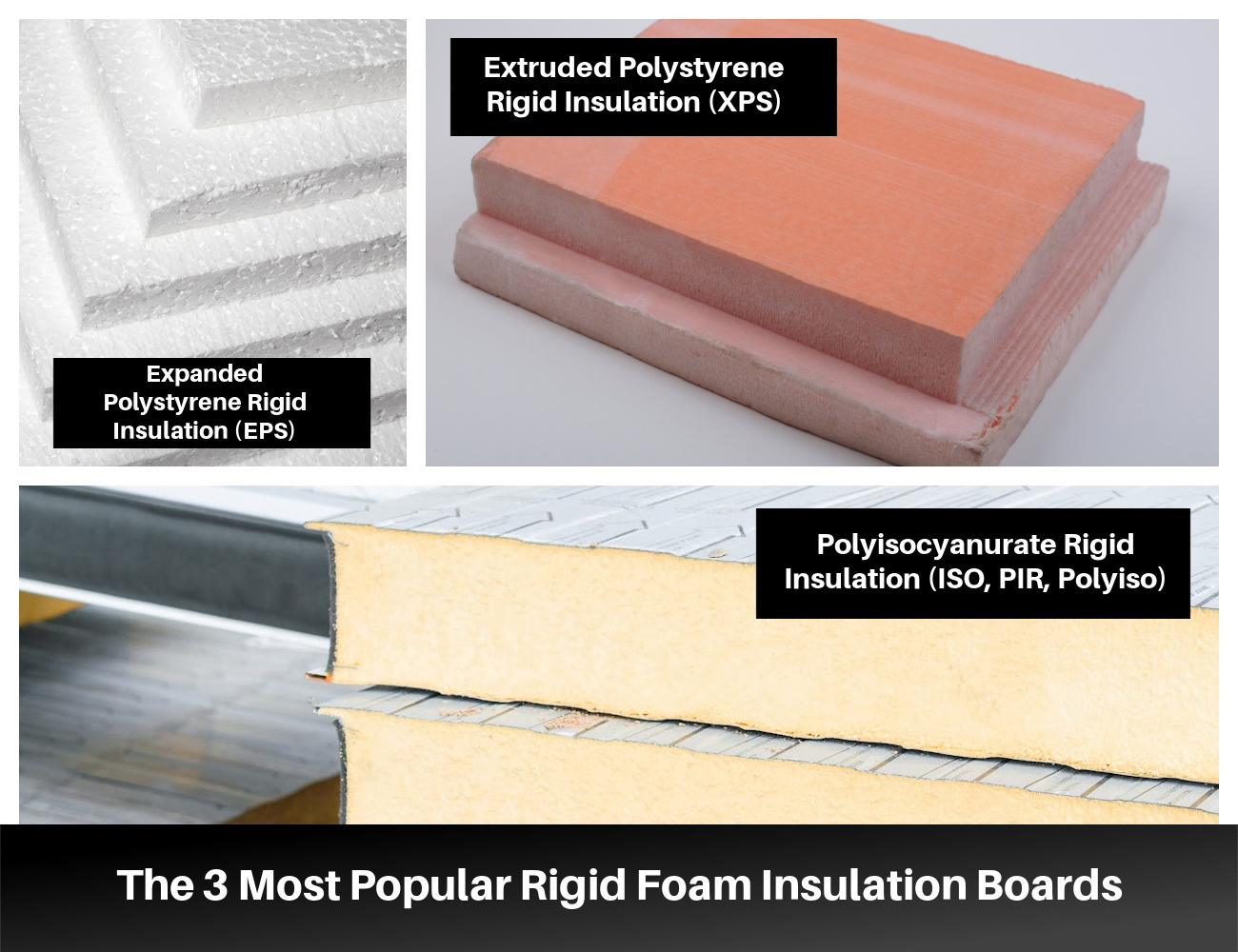Rigid foam boards provide some of the best insulation R-values per inch. But they do not perform identically and cannot be used in all situations. For instance, rigid foam is not an efficient replacement for fiberglass batts or mineral wool batts in stud wall cavities.
The three most popular rigid foam insulations–EPS, XPS, and ISO–have different R-values and different strengths and weaknesses.

Choosing the correct insulation product for your specific application involves educating yourself about the properties of each type of rigid board insulation. The following lists provide a detailed comparison of these popular and effective products.
Expanded Polystyrene Rigid Insulation (EPS)
Expanded polystyrene is manufactured by blowing pentane gas into polystyrene cells to make them larger closed cells. Almost all polystyrene insulation is 95% – 98% air. Dead air provides the insulation value of most products–including rigid foam and fiberglass batts.

Expanded polystyrene insulation is often called bead board or Styrofoam. Styrofoam is actually the trademarked name of Dow Chemical’s products. Several million tons of polystyrene are produced every year–not only for insulation.
A few uses of polystyrene include CD cases, disposable cutlery and take-out food containers, packing peanuts, molded packaging, bottles, trays, lids, etc. EPS is used extensively as insulation. Most EPS rigid insulation is white, but color can be added if necessary.
Following are some of the uses and benefits of expanded polystyrene.
- Most versatile of these three rigid foam insulation products.
- Can be used on walls, roofs, floors, and below grade.
- Insulation of choice for construction of Insulated Concrete Forms (ICF) and Structural Insulated Panels (SIP)
- Least expensive product. BUT provides the highest average R-value per dollar spent.
- Approximately R-3.6 to R-4.2 per inch depending on product density.
- Meets or exceeds most building codes and energy loss requirements.
- Approved for ground contact and below-grade applications.
- Can be ordered treated to resist insects. Not a food source but can become a nesting site for termites and other pests.
- Absorbs very little moisture and does not retain it over the long term.
- Will not act as a house wrap. Install on the exterior of walls over house wrap.
- Available faced or unfaced. Faced products act as a vapor retardant. Some specialty facings will act as vapor barriers.
- Among the most eco-friendly insulation products.
- Warranty covers 100% of R-value retention. The product does not degrade over time.
For all of its advantages, expanded polystyrene is the least used insulation board. It has a lower R-value per inch and is perceived as cheap. It also requires more space because of the extra thickness needed to achieve higher R-values.
Building codes are becoming more stringent. Some studies suggest that 90% of houses in the US are under-insulated. To reach an R-40 roof insulation value EPS needs to be approximately 12” – 15” thick.
Extruded Polystyrene Rigid Insulation (XPS)
Most people are familiar with blue expanded polystyrene rigid insulation. Made by Dow Chemicals and stamped with the Styrofoam trade name. Other colors–yellow, pink, or green–are appearing as more manufacturers make XPS foam boards. Following are some of the uses and benefits of extruded polystyrene rigid foam.

- Both cost and R-value of XPS are about in the middle range of rigid foam insulations.
- R-5.0 per inch
- Costs approximately $0.42 per square foot for a 4 x 8 sheet of 1” thick material.
- Used extensively on exterior walls under siding renovations and for below-grade insulation applications.
- Available unfaced or with a number of plastic facings.
- Semi-permeable. One inch thick unfaced product has a perm rating of about one.
- Thicker faced XPS can have lower perm ratings.
- Extruded polystyrene is stronger and more rigid than expanded polystyrene boards.
- XPS is recyclable.
- Acts as a vapor retarder, not a vapor barrier.
- Will absorb more moisture than other rigid insulation boards over time.
- Warranty does not cover long-term R-value retention because of moisture absorption.
Historically, XPS is manufactured using hydrofluorocarbons–very environmentally unfriendly products. Some manufacturers–like Dow Chemicals-Blue Styrofoam–now use hydrochlorofluorocarbon (HCFC) as a blowing agent. Not perfect, but a significant improvement–with 94% less ozone depletion.
Polyisocyanurate Rigid Insulation (ISO, PIR, Polyiso)
Polyisocyanurate rigid insulation starts out as a liquid. It has to be sprayed onto backing material during the manufacturing process. Meaning that all ISO boards are faced–typically on both sides. Following are some of the uses and benefits of polyisocyanurate rigid insulation.

- Costs approximately $0.70 per square foot for 1” thick boards.
- R-5.8 per inch. Some products like Thermax claim R-values to R-6.5.
- Used most often as roofing insulation.
- Allowed as exterior sheathing in some jurisdictions.
- Used on exterior walls under siding retrofits. (Not as effective in cold climates. May lose up to 30% more heat in cold climates.)
- Different facings affect R-value, durability, and perm ratings.
- Foil facing is by far the most common. It is considered impermeable sheathing–especially if the joints are taped. (Do not create a double vapor barrier–one inside and one outside.
- Fiberglass-faced ISO is more permeable and can be used without fear of trapping moisture in the walls.
- Foil facing becomes especially valuable in hot climates, adding reflective insulation value to the product.
- ISO is not recyclable.
- R-value degrades over time. May be noticeable in 10 – 15 years.
The post Extruded Polystyrene vs. Expanded Polystyrene vs. Polyisocyanurate appeared first on Homedit.
0 Commentaires